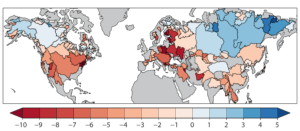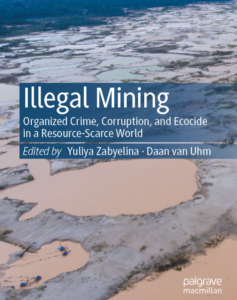A warming world is pushing us off the “snow cliff”. Snow drought is increasing. Dry fire-filled summers with low rivers and crop loss surely follow in many parts of the Northern Hemisphere. We talk with Lead Author Alexander Gottlieb from Dartmouth. Then “satellites don’t lie”. Australian mining expert Dr. Tim Werner finds twice as much mining activity and damage, half of it undocumented – the dark mining economy.
Welcome to Radio Ecoshock. I’m Alex Smith.
Listen to or download this Radio Ecoshock show in CD Quality (57 MB) or Lo-Fi (14 MB)
Yes, Buffalo got five feet of snow in the middle of January, and Central Park in New York ended 700 days without snow. That quickly melted in another unreal warm spell in the former New England winter. There may be some recovery of the snow pack with late-season wet weather, but even in the Rocky Mountains some of that now arrives as rain.
River waters across the North American West depend on those snow packs. According the U.S. Government drought index: ”In early January, snow water equivalent (SWE) observations at some SNOTEL stations in Montana, Wyoming, Idaho, Colorado, Utah, Nevada, California, Oregon, and Washington were at record low values.“
In Canada’ western mountains, the Province of British Columbia reported only 56 percent of normal in January 2024.
The European Environment Agency says the average snow cover in Europe has declined by 15% since the 1960. Many ski hills in the Alps are struggling to find enough snow days to stay open. It looks like another dry fire-prone year for much of Europe in 2024 – and possibly most years to come due to global warming.
As you will hear in our interview, even ski hills of the Himalayas are asking “Where is the snow?” this year.
Now scientists made a major discovery: a key temperature which governs whether snow accumulates or not. Let’s investigate.
================================
ALEXANDER GOTTLIEB: THE SNOW CLIFF
As the world warms, we face declining snowpack and more summer droughts. New science discovers a key temperature point governing that relationship. Beyond it, winter snowpacks do not accumulate, and summer drought affecting hundreds of millions of people likely follows. This is another sign of human-forced global warming, but forecasting snow storage is anything but simple. Finally we have the paper: “Evidence of human influence on Northern Hemisphere snow loss”.

The lead author is PhD student Alexander R. Gottlieb publishing with Justin Mankin. Both are with the Climate Modeling and Impacts Group, at Dartmouth College in New Hampshire. Together over the years they published a series of investigations into climate and snowpack.
Listen to or download my 29 minute interview with Alexander Gottlieb in CD Quality or Lo-Fi
Gottlieb and Mankin say the snowpack is “not behaving like a sentinel” for climate change. As the Paper’s Figure 1 says: “Observed long-term warming trends are robust throughout the Northern Hemisphere, but snowpack trends are not.” Why isn’t snow accumulation acting in lockstep with warming?
It is due to a magic number where snow can build or not. As Seth Borenstein and Brittany Peterson write:
“…the study found a key threshold for the future of snowpacks in the Northern Hemisphere: 17.6 degrees (-8 degrees Celsius). In places where the winter temperature average is colder than that, the snowpack often survives because it’s cold enough. But areas warmer than 17.6 degrees for a winter average tend to see their winter wonderland dreams melt like the wicked witch of the west. And it’s happening fast.”
Alex Gottlieb says we only realize there has been a trending change in snow pack, and it has crossed that critical temperature threshold – when it is already too late. This is another climate signal seen only in the rearview mirror! That is why the authors say snowpack is a poor “sentinel” or early warning system for warming. “You only see snow losses emerging once you’ve gone over that cliff” Gottlieb says in the interview.
He also says the importance of snow is that what happens in the wintertime doesn’t just stay in the winter. The snowpack acts as a giant slow release mechanism for season water, releasing when needed most for agriculture, higher power generation (hydro), and the needs of city dwellers. In some ways, winter drives the whole year.
Later he talks about the snow cliff as a fundamental relationship between the average winter temperature and the sensitivity to warming. The number (at about 8 degrees C.) is not a steep dividing line, but each added amount of warming decreases snowpack in most basins (there may be exceptions with other drivers at work…) Out of 169 major Northern Hemisphere Basins in this study, the authors found human-forced changes in 31 of them.
Many highly populated places are just on or over the edge of this temperature snow-loss cliff. They should anticipate changes to their water availability in all seasons and expect even more severe problems as the world continues to warm. “The long-term expectation of accelerating snow loss in these places is really clear – and that is a future reality we need to be planning for now.” (A. Gottlieb, Radio Ecoshock)
As a person living in the Western fire zone, and for people around the world worried about fire smoke and CO2, I ask Alexander about the relationships between snowpack and wildfires the following summer. Check out this presentation to the Western Snow Conference for more.
“What it would take would be really substantial and politically contentious investments in infrastructure to change our water management approach”. Maybe one way would be to build either dams or holding lakes to capture runoff from wet warm winters or early spring melt, storing it for high summer demand. That infrastructure would be expensive and could damage existing ecological systems and species. I suppose other solutions would be to change to drought-tolerant crops or simply to migrate to better conditions with more reliable water. Of course, those sweet spots are already populated.
While snow pack models and estimates do not agree well, Gottlieb says they treated the differences not as noise but a source of information. In the Connecticut River Basin where Gottlieb lives, the signal is clear. The snowpack in that Appalachian basin is decreasing by about 10% per decade over the last 40 years. Back in 1980 there would have been about 40% more snow in those New England mountains than now.
Gottlieb says we should give the experts and planners the money and support they need because we need to start adapting now to a less snowy future. We have to get past the crisis management stage, where we react to disasters, and get ready to adapt to those coming changes with long-lasting action. “We can’t just hop from crisis to crisis.”
There are direct winter impacts. Winter tourism, like skiing, snowboarding and snowmobiling gets hit. But so does winter logging which also counts on frozen soils, not muck, to operate in winter. “These economies are going to experience pretty dramatic socio-economic disruptions snow gets less and less reliable in the future.” Gottlieb says. “Writ large, we are really systematically underestimating the cost of climate change, and as such, we are really underestimating the cost of inaction on climate change.”
In this new paper in Nature Gottlieb and Mankin go from North America to the global picture. Here is a case right out of the headlines. In the New York Times January 16, Showkat Nanda and Sameer Yasir ask “It’s January at a Big Himalayan Resort. Where’s the Snow?”. They report, quote: “A dry winter has been devastating to Gulmarg, one of Asia’s highest ski resorts, in Indian-controlled Kashmir.”
SEE ALSO: Kashmir’s rare snowless winter sets off alarm bells
BBC 18th January 2024
In 2006 I interviewed operators at both Aspen and Whistler ski mountains. They were well aware of the threat of global warming.
MAPS FOR THIS NEW PAPER HERE

To me on the map in Figure 3, the river basins GAINING snowpack are mainly in Eastern Russia (Siberia), Alaska and the western Canadian Arctic. The biggest losers are in Eastern Europe and west-central Asia like the “Stans” (Kazakhstan to Turkmenistan.) and of course much of the American interior plains. Himalayan snow pack will decline but a bit less per decade..
AND SEE ALSO THIS 2015 PAPER LEAD BY MANKIN
Letter • Open Access The potential for snow to supply human water demand in the present and future
Justin S Mankin, Daniel Viviroli, Deepti Singh, Arjen Y Hoekstra and Noah S Diffenbaugh Published 12 November 2015 in Environmental Research Letters,
================================
TIM WERNER: THE UNKNOWN SCALE OF MINING
Global mining and processing is a major source of greenhouse gases heating the world. Just getting the coal, metal, and materials adds more warming. But a new study from satellite images reveals we don’t know the half of it. As this paper in Nature says: “Impacts for half of the world’s mining areas are undocumented”. This is shocking. Businesses access well-known databases of world mining. Governments make important decisions based on that very incomplete data.

Here to explain is Dr. Tim Werner a Research Fellow in the School of Geography, Earth and Atmospheric Sciences, at the University of Melbourne in Australia.
Listen to or download my 26 minute interview with Tim Werner in CD Quality or Lo-Fi
Only a few studies and books cover the scope of illegal mining. They find criminal gangs, child labor, even slave labor, and toxic left-overs ruining rivers and landscapes. But Werner cautions most undocumented mining is in countries that can’t keep track, or untracked for other reasons rather than purposefully hidden.

In this Comment in Nature January 3rd 2024 Werner suggests four steps to correct our mining blindness. The first is to stop kidding ourselves that we already know what is going on. Werner and Victor also talk about lack of transparency. I can vouch for that. Trying to research for this interview I was blocked by paywalls, complications and just hidden or missing key data all over the place. Can that be fixed?
Global satellite images contain vast amounts of data. Can you we Artificial Intelligence to start tracking world mining and it’s impacts – and then make that available to all?
DE-FOSSILIZING MINING
Right now mining requires very large amounts of fossil fuels to operate, and more to process the ore. There were reports of one copper mine in Chile running on solar power. Our guest Tim Werner co-authored a 2023 PNAS paper “How to fuel an energy transition with ecologically responsible mining“. Is there a move to slash emissions in the mining industry? What should be done?
A July 2022 paper in the Journal for Cleaner Production estimated damages from emissions in the global mining and resource sector add up to three trillion US dollars, every single year. These essential minerals cost a lot more than we think. we all pay extra with wrecked weather extremes! It’s a shame the public is so uninterested and uninformed about the real cost of resource extraction.
Emissions from mining cause ‘up to £2.5tn’ in environmental damages each year
The mining industry is so greenhouse gas intensive that an MIT article concludes:
“Meeting our global climate goals will not be possible if the mining and metals industry does not invest heavily in renewable energy and in new low-carbon technologies.”
ISSUES
I took issue with two points in the conclusion by Werner et al . First, they say “Mining will inevitably expand, including in environments that have been relatively untouched”. There are scenarios where expansion might not happen, from a severe economic crash to a tiny chance humans may try to protect those untouched areas. Is it inevitable?
What if a series of crisis or social crashes either drastically lower demand or prevent mining or shipment? What is a damaged world finally says “no” to new mining permits – and demands metals be salvaged and cycled from previous products buried in landfills? Somehow the lasting damage from a giant human population must end, whether by choice or by the forces of nature. Like everything, mining cannot expand forever.
Is this why we see such chatter about mining asteroids, planets or the moon? How serious is that – or is that a scam too?
Second, Tim and Victor conclude “Now is the time to ensure we have the best possible data to assess what the impacts and risks will be.” Not to be rude, but what difference will that knowledge make when we already ignore and go against the climate data we already have?
The Nature Comment did not dwell on damages from mining, but Tim Werner has studied exactly that. I asked him about his October 2023 study “Patterns of infringement, risk, and impact driven by coal mining permits in Indonesia”. This is free to read here.
THE MINING DAMAGE SCALE… (Alex)
We also have to consider ranking of impacts. Medieval mines had less surface visible impact other than the opening and the tailings. That changes radically with open-pit mining which scrapes away the surface. Even worse, is your mineral buried under a mountain? Blow the top of the mountain off. Now mining is changing fundamental geography, flattening mountain ranges.
All the rock blown up has to go somewhere. Might as well dump it in this nearby stream valley, fill it up, level the land off. The result is a total geographic change, domination of the water systems and all nature depending on them.
Also high on the damage ranking list: the toxicity of the tailings and the product. Uranium mining is extra-damaging because of radioactivity, which can travel a long way by air, dust, or waterways. Many benign sounding operations, like copper mining, can leave immense amounts of toxic heavy metals.
MORE MINING AND CLIMATE CHANGE INFO
Check out this explainer from MIT and the report “Climate Change and Mining. A Foreign Policy Perspective”.
=====================
DARK DEEDS AT SEA
We don’t really know the human boot-print on nature. All the official maps and business registers did not show about half the world’s actual mining. Now a new study shows up to three quarters of industrial fishing is not tracked or accounted for. The paper is titled “Satellite mapping reveals extensive industrial activity at sea”. It outlines the dark ocean web of ships scraping away life from the ocean night and day. that also means at least a third of energy and emissions from international shipping is hidden. This team “used AI and satellite imagery to map ocean activities that take place out of sight, including fishing, shipping and energy development”. I tried to get an author to tell us more. No luck.
So when billionaires gather at DAVOS, or oil lobbyists at the COP climate conferences, they only have half the real picture at best. Governments and the United Nations do not know the full scope of human activity or damage. As usual, it is much worse than you have been told. That is why emergency action to save what remains of living systems is needed immediately. We need to pierce the facade of ever-growing wealth to find the crumbling foundations, to save disappearing life that supports us all.
RE THE COLD SNAP AND WARMING
Many of you went through an ugly cold snap have to deal with chirpy people saying “Where is global warming now?” Send them my link to my earlier Ecoshock show “Climate Disruption: Extreme Cold This Winter”. Top weather expert Dr. Judah Cohen explains why waves of extreme cold and snow are more likely in the Northern Hemisphere – BECAUSE the world is warming.
And remind the doubters to enjoy dwindling winters while they last.
In the middle of January, the warmest place in all of Canada was in Nunavut, at a remote airport near the Arctic Ocean. The same week, it rained in Greenland. That is impossible, insane. One theory: an overheated winter Arctic is pushing it’s cold further south. Other scientists like Stefan Rahmsdorf says the destabilized Jet Stream is NOT caused by Arctic Warming. Either way, we changed the atmosphere. New rules tomorrow.
I’m Alex. Thank you for listening, and caring about our world.
***** CAN YOU HELP WITH EXPENSES?
Radio Ecoshock has a few monthly expenses. For example, we pay money to Soundcloud to keep our large collection of shows there. I send $25 a month to another non-profit radio distribution site, plus fees to the Pacifica radio network. There are server costs to allow many gigabytes of radio downloads a day – by people all over the world. It costs a little to keep pumping these voices of climate sanity out there. Most of these expenses are paid for by listeners (and readers) like you. If you support the project of getting Radio Ecoshock out to the world, free and ad-free, please chip in here.